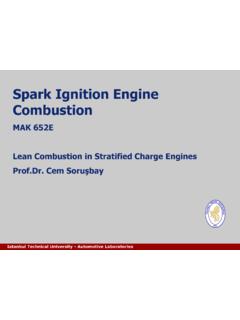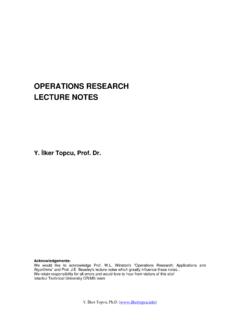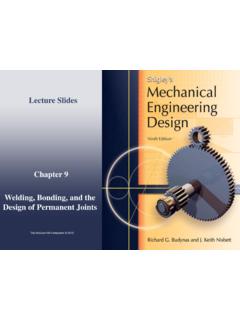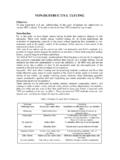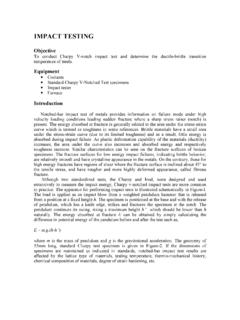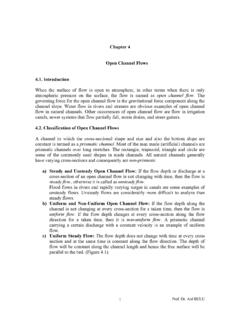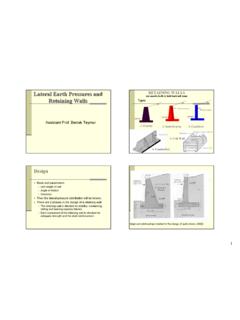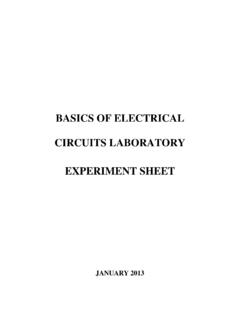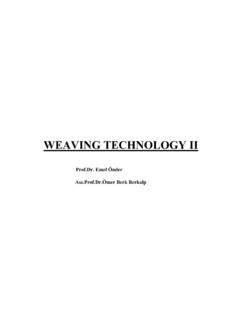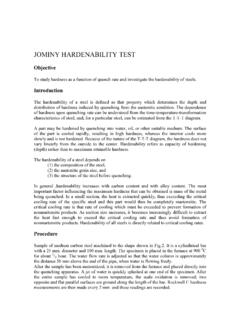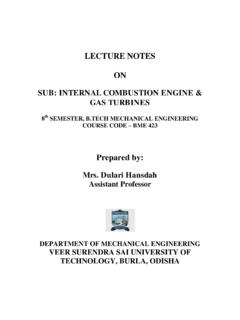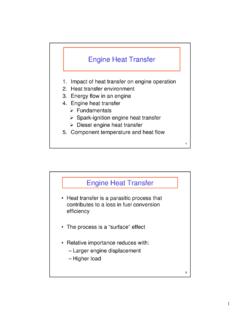Transcription of Principles of Engine Operation - İTÜ
1 Internal Combustion Engines MAK 4070E. Principles of Engine Operation Cem Soru bay Istanbul Technical University information Cem Soru bay .T.. Makina Fak ltesi Motorlar ve Ta tlar Laboratuvar . Maslak Kamp s , Ayaza a stanbul Tel. 212 285 3466. 1. Course Plan Principles of SI and CI Engine Operation , 2-stroke engines, 4-stroke engines Ideal standard cycles, thermal efficiencies, comparison, deviations Classification of Engine fuels Characteristics of Engine fuels, knock resistance, ignition tendancy, ccombustion chemistry (air excess ratio, calorific value, adiabatic flame temperature, dissociation).
2 Real Engine strokes, induction stroke, volumetric efficiency Compression stroke, combustion in SI engines and influencing parameters Abnormal combustion, parameters influencing knock and early ignition Combustion in CI engines, parameters influencing ignition delay Expension and exhaust strokes, exhaust emissions Mixture preparation in SI engines Carburator fundamentals, fuel injection, control of A/F ratio Mixture preparation in CI engines, injection pumps, injectors Fuel injection systems in Diesel engines, Atomization, combustion chamber types in Diesel engines Engine characteristics and performance.
3 Assessment Criteria Percentage Quiz 5 x 10 = 50 %. Final examination 50 %. 2. References Textbook Heywood, , Internal Combustion Engine Fundamentals, McGraw Hill Book Company, New York, 1988. Soru bay, C., IC Engine , Lecture Notes, .T.., 2001 (soft copy). Other References Soru bay, C. et al., ten Yanmal Motorlar, Birsen Yay nevi, stanbul, 1995. Pulkrabek, , Engineering Fundamentals of the Internal Combustion Engine , Prentice Hall, New Jersey, 1997. Stone, R., Introduction to Internal Combustion Engines, Macmillan, London, 1994. Other references given in the list (see web page of the course).
4 Internal Combustion Engines MAK 493E. Principles of IC Engine Operation Introduction Operation Principles Classification of engines Four-stroke and two-stroke engines SI engines, CI engines 3. Introduction Internal Combustion Engines (IC-engines) produce mechanical power from the chemical energy contained in the fuel, as a result of the combustion process occuring inside the Engine IC Engine converts chemical energy of the fuel into mechanical energy, usually made available on a rotating output shaft. Chemical energy of the fuel is first converted to thermal energy by means of combustion or oxidation with air inside the Engine , raising the T and p of the gases within the combustion chamber.
5 The high-pressure gas then expands and by mechanical mechanisms rotates the crankshaft, which is the output of the Engine . Crankshaft is connected to a transmission/power-train to transmit the rotating mechanical energy to drive a vehicle. Spark ignition ( SI ) engines Otto or gasoline engines Compression ignition ( CI ) engines Diesel engines Introduction Most of the internal combustion engines are reciprocating engines with a piston that reciprocate back and forth in the cylinder. Combustion process takes place in the cylinder. There are also rotary engines In external combustion engines, the combustion process takes place outside the mechanical Engine system 4.
6 Early History Atmospheric engines Earliest IC engines of the 17th and 18th centuries are classified as atmospheric engines. These are large engines with a single cylinder which is open on one end. Combustion is initiated at the open cylinder and immediately after combustion, cylinder would be full of hot gases at atmospheric pressure. The cylinder end is closed at this time and trapped gases are allowed to cool. As the gases are cooled, vacuum is created within the cylinder causing pressure differential across the piston (atmospheric pressure on one side and vacuum on the other side).
7 So piston moves due to this pressure difference doing work. Early History 5. Early History Huygens (1673) developed piston mechanism Hautefeuille (1676) first concept of internal combustion Engine Papin (1695) first to use steam in piston mechaanism Modern engines using same Principles of Operation as present engines previously no compression cycle Lenoir (1860) driving the piston by the expansion of burning products - first practical Engine , HP. later kW engines with mech efficiency up to 5%. Rochas (1862) four-stroke concept was proposed Otto Langen (1867) produced various Engine improved efficiency to 11%.
8 Otto (1876) Four-stroke Engine prototype built, 8 HP and patented Clark (1878) Two-stroke Engine was developed Diesel (1892) Single cylinder, compression ignition Engine Daimler/Maybach (1882) Incorporated IC Engine in automobile Introduction VC clearence volume VD displacement volume VT total volume D bore L stroke TDC top dead center BDC bottom dead center 6. Introduction A single cylinder 4-stroke Engine Introduction 7. Introduction a single cylinder, 4-stroke Engine Introduction a Diesel Engine 8. Introduction Introduction 9. Classification of Engines By application motorcycles, scooters, 70 kW, SI, 2- and 4-stroke passenger cars, 15 200 kW, SI and CI, 4-stroke light commercial vehicles, 35 150 kW, SI and CI, 4-stroke heavy commercial vehicles, 120 400 kW, Diesel, 4 zamanl.
9 Locomotives, 400 3 000 kW, CI, 4-stroke ships, 3 500 22 000 kW, CI, 2- and 4-stroke airplanes, 45 3 000 kW, SI, 4-stroke stationary engines, 10 20 000 kW, CI, 2- and 4-stroke Classification of Engines Basic Engine design Reciprocating engines, subdivided by arrangement of cylinders Rotary engines 10. Classification of Engines Single-cylinder Engine Otto gasoline Engine Classification of Engines Single-cylinder test Engine . 11. Classification of Engines In-line Engine Classification of Engines In-line Engine 12. Classification of Engines Opposed piston Engine Classification of Engines V - Engine 13.
10 Classification of Engines V Engine Ferrari V8 90o Engine 360 Modena 3586 cc Bore/Stroke 85/79 mm 294 kW (400 hp) @ 8500 rpm 373 Nm @ 4750 rpm Classification of Engines Ferrari V8 90o Engine 360 Modena 3586 cc 14. Classification of Engines V Engine Ferrari V12 65o Engine 375 kW (485 hp) @ 7000 rpm 550 Barchetta Pininfarina Nm @ 5000 rpm Bore/Stroke 86/75 mm 5474 cc Classification of Engines Radial Engine 15. Classification of Engines Radial Engine Rotary Engines Wankel Engine (Felix Wankel, prototype in 1929, patented double rotor in 1934). 16. Rotary Engines Rotary Engines Mazda Rx-8 Triple rotor Engine by Mazda 250 hp Engine 17.
